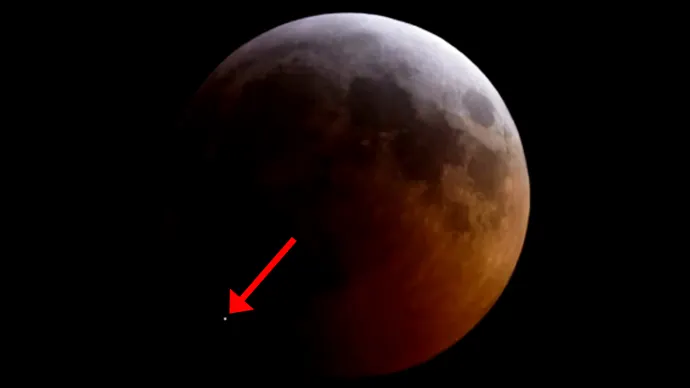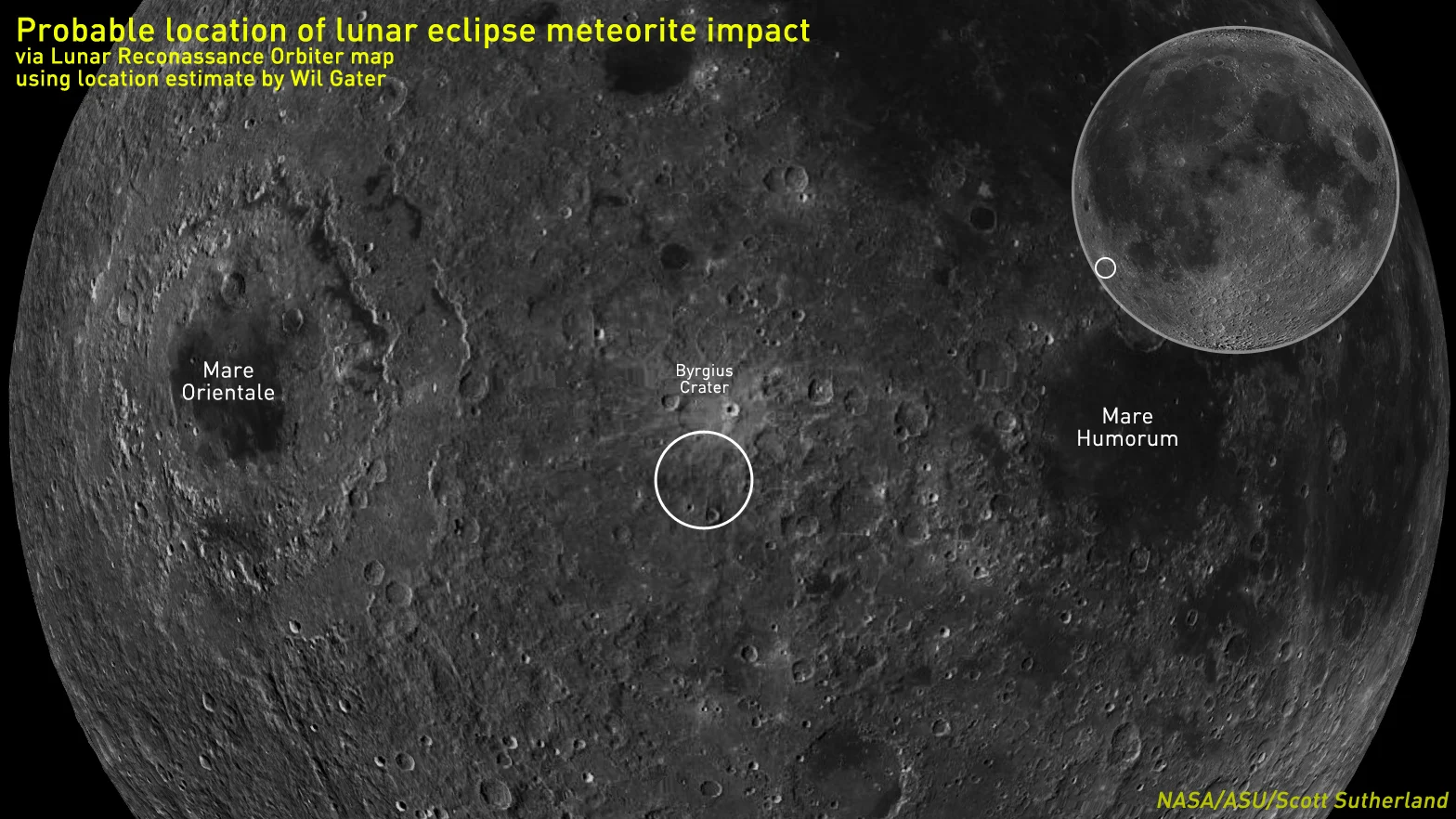
Meteorite strike caught during Super Blood Wolf Moon eclipse
Sunday night's Super Blood Wolf Moon gave us all an extra special treat, as cameras captured the bright flash of a meteorite impacting the Moon, just as the eclipse reached totality!

The arrow points to the flash of light produced by a small meteoroid striking the Moon, just as the Super Blood Wolf Moon eclipse reached totality. Credit: Griffith Observatory/Scott Sutherland
With so many eyes glued to the sky Sunday night, watching the January Full Moon pass through Earth's shadow in a total lunar eclipse, the timing couldn't have been better for us to witness something unusual.
At 11:41 p.m. ET, just as the eclipse was entering 'totality', when the Moon was completely enveloped by Earth's dark umbral shadow, viewers reported spotting a tiny bright flash, just for a moment, close to the southeastern limb of the Moon.
The above animation was captured from the Griffith Observatory livestream video, at exactly 3 hours, 43 minutes and 11 seconds into the broadcast.
Now, if this tiny flash was only spotted via one camera, it could be chalked up to a glitch in the instrumentation, or perhaps in the video feed, however, at least five video streams saw the same thing, from different locations, and there have been a number of reports of observers either seeing it or photographing it, independently.
The animation below is from the TimeandDate.com livestream, at exactly 1 hour, 20 minutes and 47 seconds.
So, what was this flash?
With it appearing in different feeds, from distant locations, but spotted in the exact same place, it was definitely something happening on the Moon. If it was something in our atmosphere, only one of the feeds would have picked it up, or given the distance between the two cameras, the flash would have at least shown up in quite a different location in the sky for one of them, due to the change in perspective.
According to astronomer Wil Gater, based on the images he has seen, the flash likely occurred just south of Byrgius Crater on the Moon, west of Mare Humorum.

The circle indicates the probable location of the meteorite impact during the Super Blood Wolf Moon lunar eclipse, on January 20-21, 2018, via ASU's Lunar Reconnaissance Orbiter Camera QuickMap browser. Credit: NASA/Arizona State University/Scott Sutherland
There are various landers and rovers on the lunar surface, however none are in that location, and none are capable of sending out a beam of light, let alone one bright enough to be seen from Earth. There are four artificial satellites in lunar orbit as well (NASA's Lunar Reconnaissance Orbiter, the twin ARTEMIS spacecraft and China's Chang'e 5-T1 test orbiter), but the same goes for them. None have the capability of sending a flash of light back to us. Also, with the Moon deep inside the umbra at that point, there would be no direct sunlight reaching the Moon for any metallic surfaces to reflect back to us (although such a reflection is very unlikely to be bright enough for us to see, anyway).
The most likely explanation? It was a meteorite impact!
This was first suggested on Reddit, as user 'ahecht' spotted the flash while watching the eclipse, and confirmed what he saw via the timeanddate.com livestream. After that, astronomers began searching for more views from video feeds and from astrophotographers.
Chris Lintott, an astronomer with the University of Oxford, estimated that the object that caused this flash could be only a few centimetres across, while Jose Maria Madiedo, from the University of Huelva's MIDAS project, said it may be something the size of a football.
How could something so small cause a flash of light bright enough to be visible all the way here on Earth?
For one, the darkness that had fallen across the lunar surface at this point made it very easy to pick out. Had the eclipse not been happening, the brightness of the lunar surface likely would have made it impossible to see. Also, the object may have been small, but it would have been carrying a lot of energy with it, due to its speed.
Meteoroids that hit the top of Earth's atmosphere are travelling at speeds of between 40,000 km/h and 250,000 km/h. For comparison, a typical bullet is fired at a speed of around 1,300 km/h. So, with so much energy, even a rock that could fit into the palm of your hand can release a tremendous flash upon hitting the lunar surface, if it was travelling fast enough.
It might be impossible to know exactly how big the object really was. The same flash could have been produced by a bigger object travelling towards the slower end of the scale (closer to 40,000 km/h), or a smaller object with a speed towards the faster end.
The impact was also captured by MIDAS cameras, operating from Spain.
According to New Scientist, Madiedo said that this was not the first meteorite strike recorded by MIDAS, but it was the very first recorded by the project during a lunar eclipse.
What's next?
It might be possible for NASA's Lunar Reconnaissance Orbiter to see a new crater on its next pass over the area of impact! We'll just have to wait and see what it can show us!
Update! Justin Cowart, a Martian geologist and one of the first scientists to start investigating this, said on Twitter that the crater that formed from this impact could be between 1 and 10 metres wide!
Sources: Reddit | Griffith Observatory | Timeanddate.com | Jose Maria Madiedo/MIDAS | New Scientist











